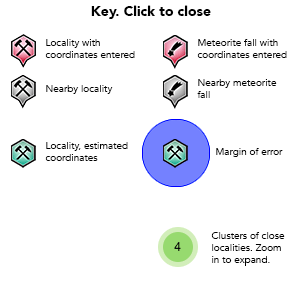Big Stubby, Marble Bar, East Pilbara Shire, Western Australia, Australia

| Latitude & Longitude (WGS84): | 21° 13' 12'' South , 119° 45' 10'' East |
|---|---|
| Latitude & Longitude (decimal): | -21.22004,119.75300 |
| GeoHash: | G#: qsjpm112r |
| Köppen climate type: | BWh : Hot deserts climate |
Big Stubby is 6 kilometres south-east of Marble Bar as a small VMS deposit. There are seven sub-vertical lenses of Zn-Pb-Cu-Ba mineralisation, within felsic to intermediate volcanic and volcaniclastic rocks near the top of the Duffer Formation.
Mineralisation is associated with chert bands interlayered with turbiditic tuff, and overlying a sequence of tuff breccias, volcaniclastic conglomerate, and turbiditic tuff. The Pb-Zn mineralisation lies stratigraphically above a copper rich zone, with barite and gypsum in lateral extensions of the lenses.
Several companies have explored the deposit but it is too small to be economic. This is a saving grace, as the deposit has far more importance scientifically to be destroyed by mining. The deposit provides the most primitive ore lead known to date according to the source at 3472 Ma. The high lead-barite deposit is atypical for VMS deposits in Archaean aged rocks.
Around the same time (late 1970's), microfossils of bacteria and algae were found by a joint U.W.A./CSIRO team dated 3.46 billion years, pushing back the date of first life on the planet by 700 million years.
Resource 0.1-0.2 Mt but high grade at 13.8% Zn, 4.5% Pb, 350 g/t Ag and 20% Ba.
Mineral List
11 valid minerals.
Rock Types Recorded
Select Rock List Type
Alphabetical List Tree DiagramRegional Geology
This geological map and associated information on rock units at or nearby to the coordinates given for this locality is based on relatively small scale geological maps provided by various national Geological Surveys. This does not necessarily represent the complete geology at this locality but it gives a background for the region in which it is found.
Click on geological units on the map for more information. Click here to view full-screen map on Macrostrat.org
| Mesoarchean - Paleoarchean 2800 - 3600 Ma ID: 3189906 | Archean intrusive rocks Age: Archean (2800 - 3600 Ma) Comments: Pilbara Craton Lithology: Intrusive igneous rocks Reference: Chorlton, L.B. Generalized geology of the world: bedrock domains and major faults in GIS format: a small-scale world geology map with an extended geological attribute database. doi: 10.4095/223767. Geological Survey of Canada, Open File 5529. [154] |
| Paleoarchean 3200 - 3600 Ma ID: 693346 | Coongan Subgroup Age: Paleoarchean (3200 - 3600 Ma) Stratigraphic Name: Coongan Subgroup Description: Felsic volcanic rocks, felsic schist, basalt, dacite, andesite, sandstone, conglomerate, amphibolite, komatiite, peridotite, chert, psammitic and pelitic schist, mafic schist, wacke, shale, iron formation, ultramafic schist. Comments: sedimentary; igneous felsic volcanic; synthesis of multiple published descriptions Lithology: Sedimentary; igneous felsic volcanic Reference: Raymond, O.L., Liu, S., Gallagher, R., Zhang, W., Highet, L.M. Surface Geology of Australia 1:1 million scale dataset 2012 edition. Commonwealth of Australia (Geoscience Australia). [5] |
Data and map coding provided by Macrostrat.org, used under Creative Commons Attribution 4.0 License



